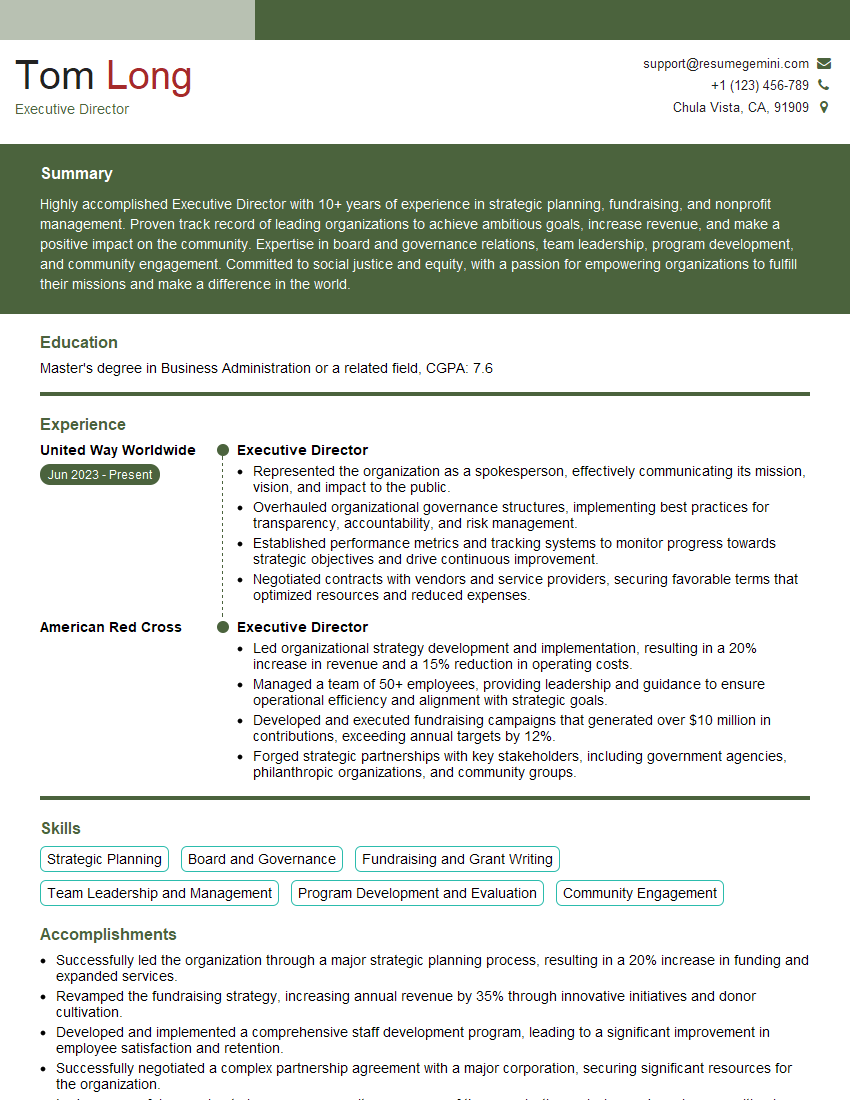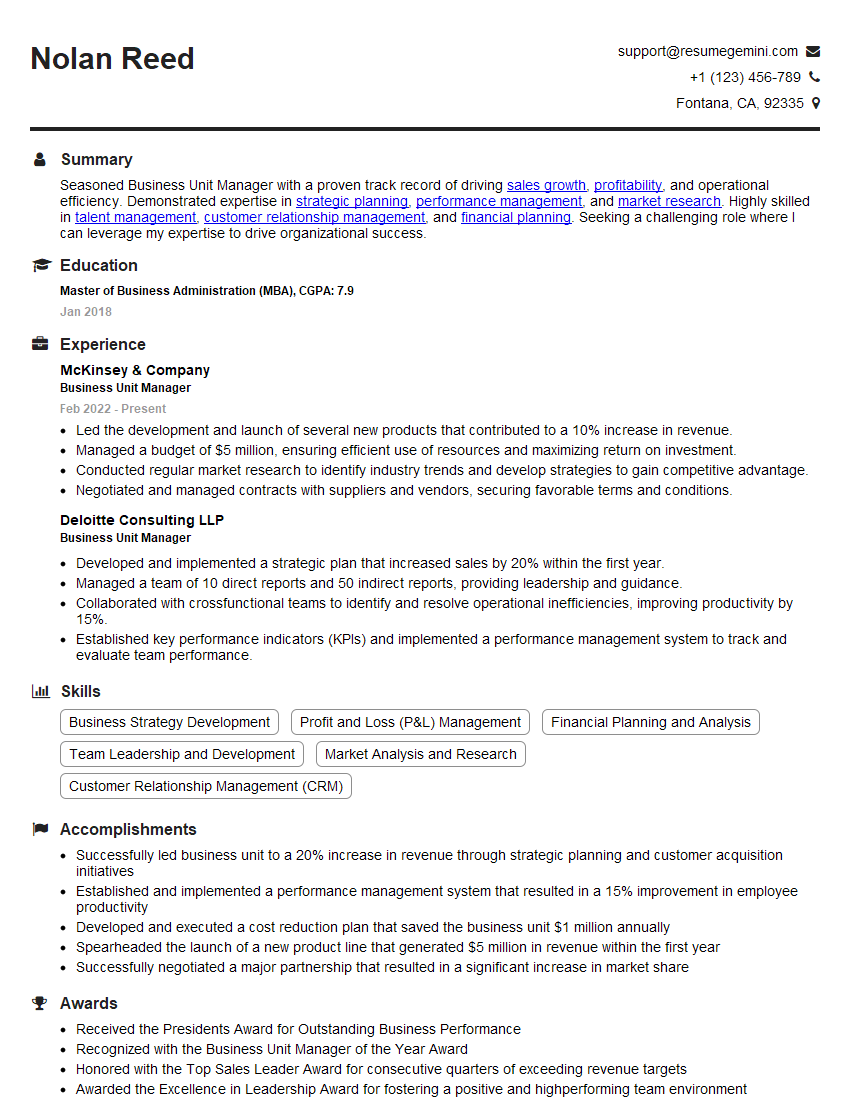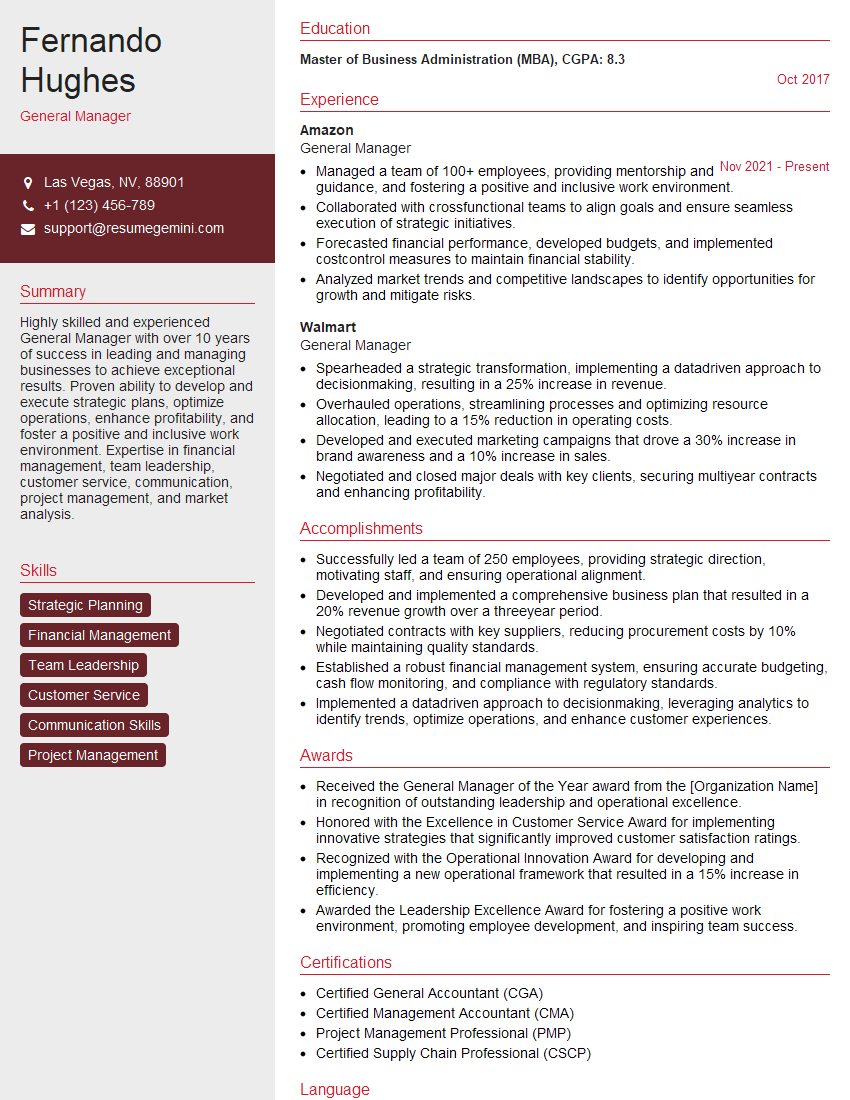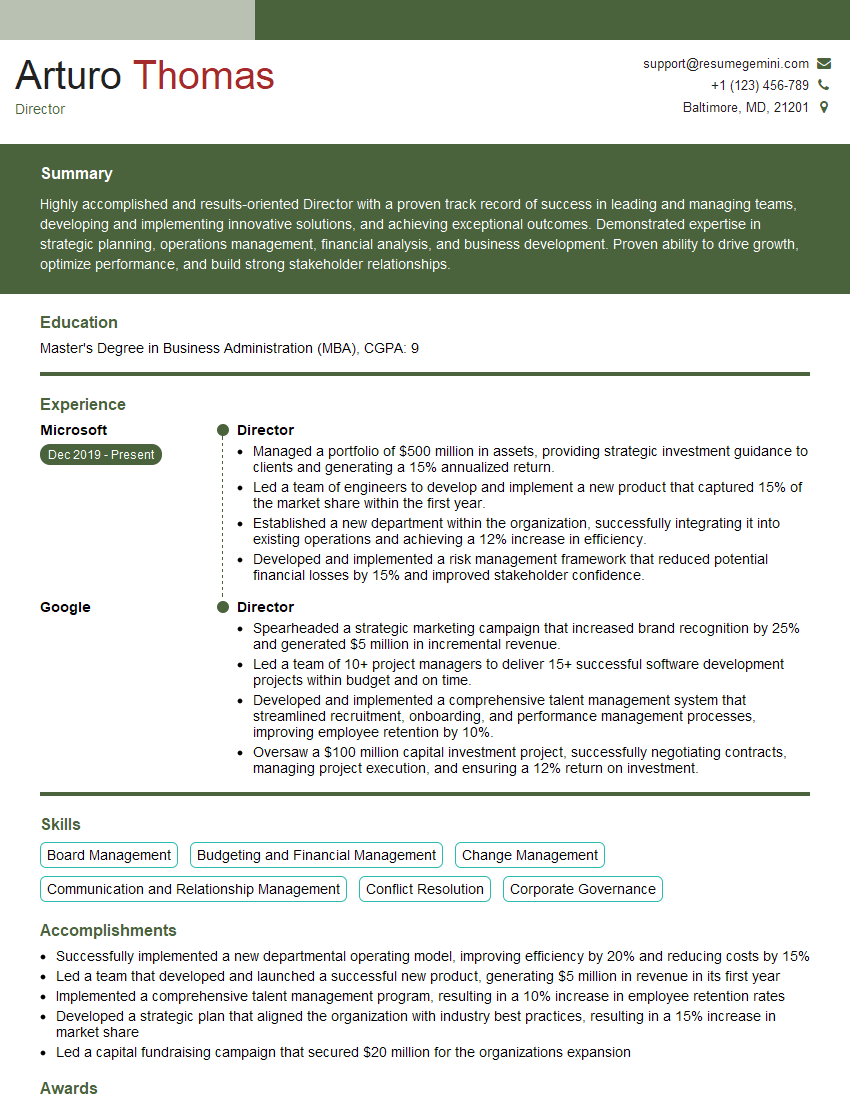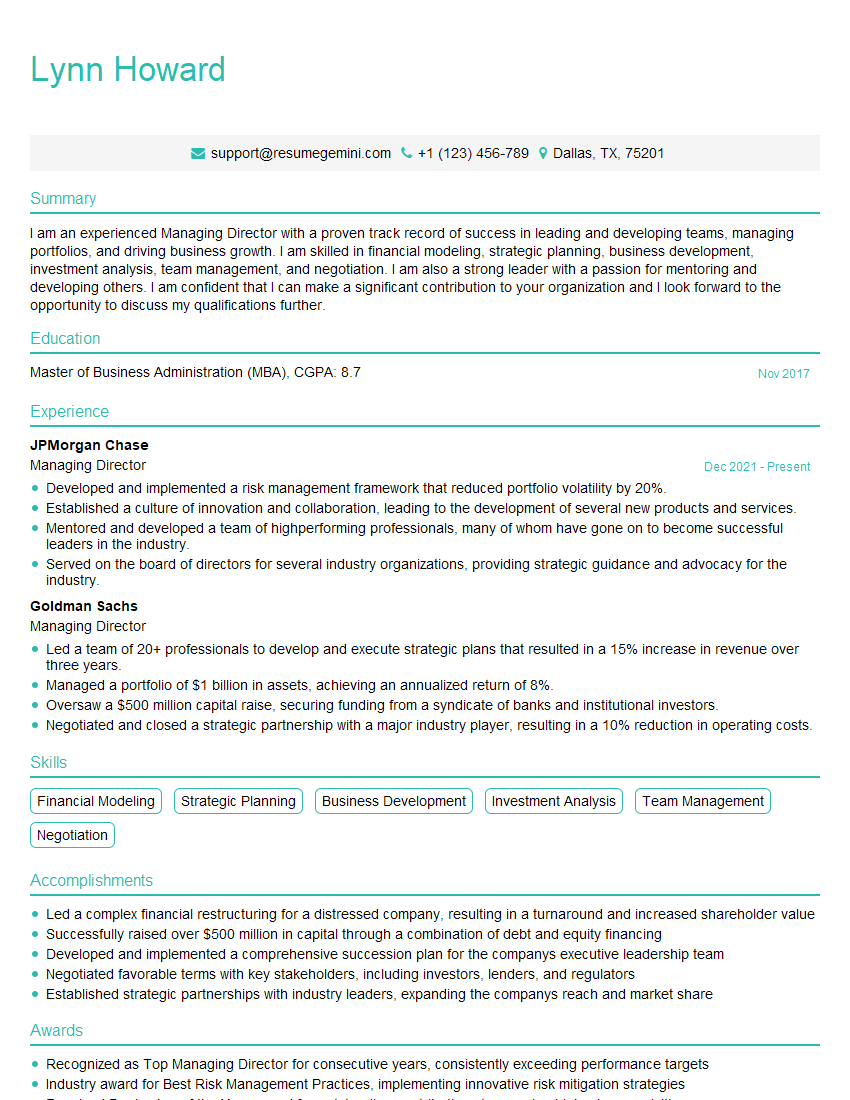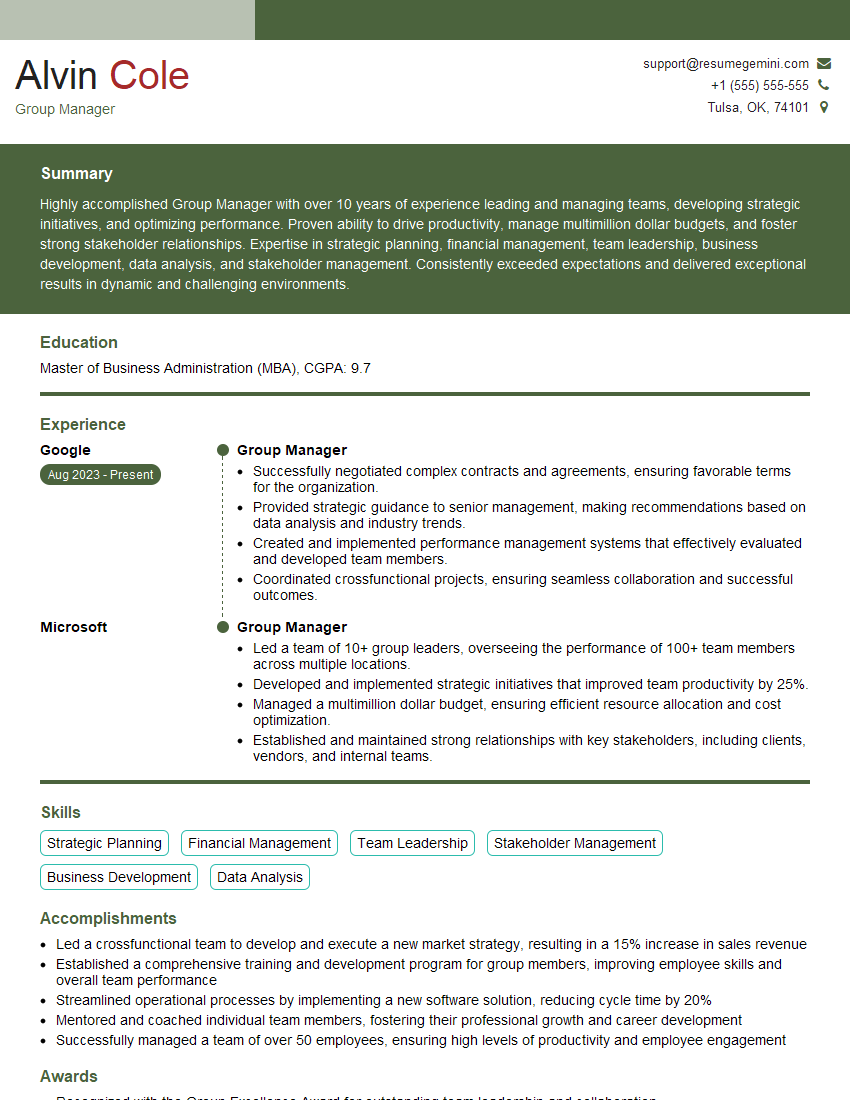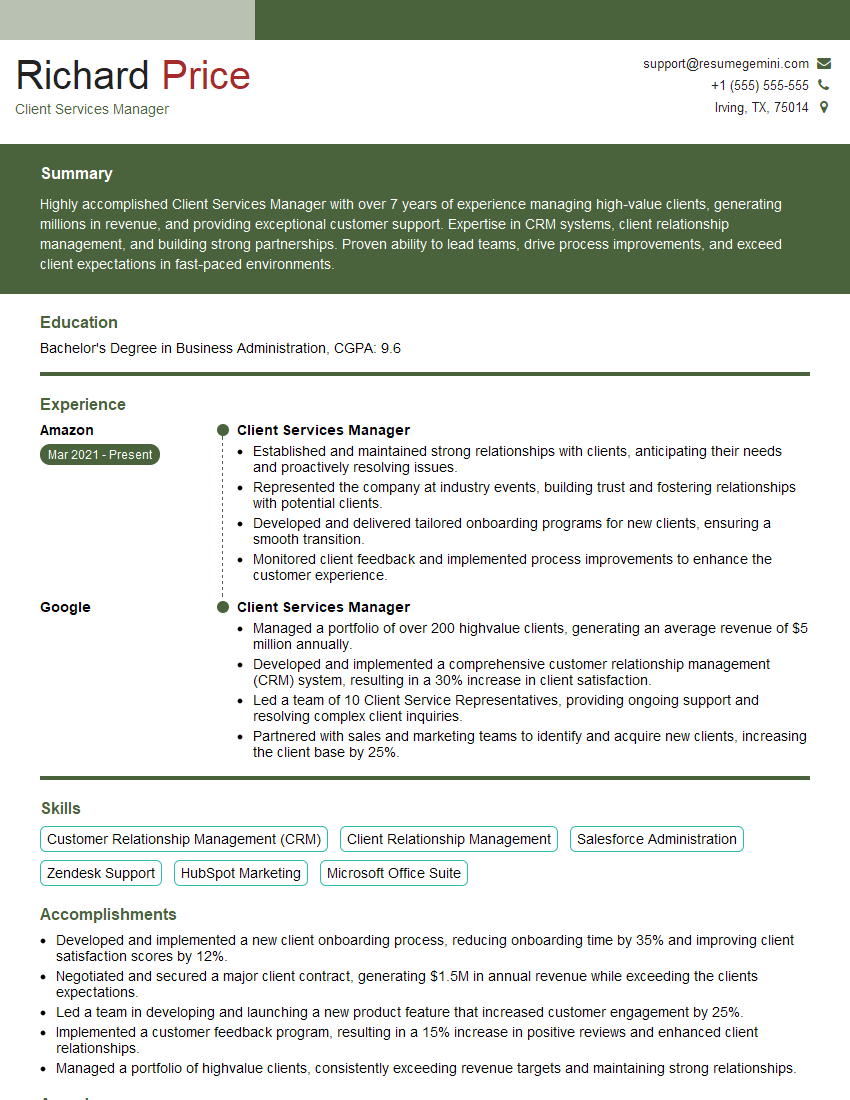Feeling uncertain about what to expect in your upcoming interview? We’ve got you covered! This blog highlights the most important Ability to lead and motivate cross-functional teams interview questions and provides actionable advice to help you stand out as the ideal candidate. Let’s pave the way for your success.
Questions Asked in Ability to lead and motivate cross-functional teams Interview
Q 1. Describe your experience leading cross-functional projects with conflicting priorities.
Leading cross-functional projects with conflicting priorities requires a strategic approach focusing on prioritization, clear communication, and collaborative problem-solving. I’ve encountered this many times, most notably during a product launch where the marketing team wanted a faster rollout than the engineering team deemed feasible.
My approach involved:
- Prioritization Matrix: We used a weighted prioritization matrix to objectively assess the value and risk associated with each task across departments. This allowed us to visualize the trade-offs and make data-driven decisions about which tasks to prioritize.
- Joint Planning Sessions: I facilitated regular meetings with representatives from all departments involved. This fostered open dialogue, allowing us to identify and address potential conflicts proactively. We collaboratively adjusted timelines and resource allocation, ensuring everyone understood the rationale behind the decisions.
- Regular Status Updates: Transparent and frequent updates kept everyone informed about the project’s progress, potential roadblocks, and any necessary adjustments to the plan. This helped maintain team morale and prevent misunderstandings.
The result was a successful product launch, albeit slightly delayed, with minimal impact on core features. The key was to balance speed with quality and to ensure everyone felt heard and valued throughout the process.
Q 2. How do you identify and address personality conflicts within a cross-functional team?
Personality conflicts can derail even the most well-planned cross-functional projects. Identifying them requires keen observation and active listening. I typically look for signs such as passive-aggressive communication, unwillingness to collaborate, and frequent interruptions during meetings.
My strategy for addressing these conflicts includes:
- Private Conversations: I address concerns privately with each individual involved, focusing on understanding their perspectives and concerns without judgment. I aim to reframe the conflict as a problem to be solved collaboratively rather than a personal attack.
- Mediation: If private conversations don’t resolve the issue, I facilitate a structured mediation session. I focus on creating a safe space for open communication, helping each individual understand the other’s viewpoint, and jointly identifying solutions.
- Redefining Roles: In some cases, adjusting team roles or responsibilities can help alleviate conflict. This might involve reassigning tasks to better leverage each individual’s strengths and minimize direct interaction between conflicting individuals.
- Setting Clear Expectations: Sometimes, conflicts arise from unclear expectations. Reinforcing team norms and communication protocols can significantly reduce friction.
It’s important to remember that conflict is not always negative. When managed effectively, it can lead to improved communication and a stronger team.
Q 3. Explain your approach to conflict resolution in a cross-functional setting.
My approach to conflict resolution in a cross-functional setting is based on collaboration, empathy, and a focus on finding mutually beneficial solutions. I utilize a structured approach that combines active listening, collaborative problem-solving, and clear communication.
Steps I usually take:
- Identify the root cause: I begin by thoroughly understanding the underlying cause of the conflict, not just the surface-level symptoms. This often involves asking open-ended questions and actively listening to all parties involved.
- Separate the people from the problem: I emphasize separating the emotional aspects of the conflict from the factual issues. This helps to avoid personal attacks and maintain a respectful dialogue.
- Focus on shared goals: I remind the team members of their shared objectives and how resolving the conflict contributes to the overall project success.
- Generate solutions collaboratively: I encourage the team to brainstorm potential solutions together, fostering a sense of ownership and shared responsibility for the outcome.
- Document the agreement: Once a solution is agreed upon, I document it clearly and distribute it to all parties to ensure everyone is on the same page.
I believe in fostering a culture of respectful communication where disagreements are viewed as opportunities for growth and improvement.
Q 4. How do you ensure consistent communication and information sharing across different departments?
Consistent communication and information sharing are crucial in cross-functional teams. I employ a multi-pronged approach to ensure this happens effectively.
My strategies include:
- Centralized Communication Hub: Utilizing project management software (like Asana, Jira, or Monday.com) provides a central repository for all project-related documents, updates, and discussions. This ensures everyone has access to the same information in real-time.
- Regular Team Meetings: Scheduling consistent team meetings (daily stand-ups, weekly progress reviews) provides opportunities for updates, discussion, and problem-solving. Agendas are crucial to keep these meetings productive.
- Cross-Departmental Communication Channels: Establishing dedicated communication channels (e.g., Slack channels or email distribution lists) for specific projects or tasks ensures efficient information flow between relevant departments.
- Visual Reporting: Utilizing dashboards and visual reports provides a clear overview of project progress, key metrics, and potential bottlenecks. This allows for quick identification of issues and facilitates informed decision-making.
The key is to choose tools and methods that fit the team’s size, working style, and project complexity. Adaptability is essential.
Q 5. What strategies do you use to motivate team members with diverse backgrounds and skillsets?
Motivating a diverse team requires understanding individual needs and preferences. My approach is to create a supportive and inclusive environment that leverages each team member’s unique strengths.
My strategies include:
- Recognition and Appreciation: Publicly acknowledging individual and team accomplishments, both big and small, boosts morale and creates a positive work environment. I make sure to celebrate successes and highlight individual contributions.
- Individualized Approaches: I recognize that different people are motivated by different things. Some value autonomy, while others prefer structured guidance. I tailor my approach to each team member’s preferences and working style.
- Empowerment and Ownership: Empowering team members by giving them autonomy and ownership over their work increases engagement and job satisfaction. I encourage them to take initiative and contribute their ideas.
- Clear Expectations and Goals: Setting clear, measurable, achievable, relevant, and time-bound (SMART) goals provides direction and clarity, which is essential for motivation. Everyone understands what success looks like.
- Professional Development: Investing in team members’ professional development demonstrates care and commitment. This can include providing opportunities for training, mentorship, or conferences.
By fostering a supportive and inclusive culture, I strive to create a team where every member feels valued and empowered to contribute their best work.
Q 6. Describe a time you had to delegate tasks effectively within a cross-functional team.
Effective delegation is critical for efficient cross-functional teamwork. During a website redesign project, I had to delegate tasks across the design, development, and content teams.
My approach involved:
- Clear Task Definition: I clearly defined each task, outlining specific deliverables, timelines, and expected outcomes. This ensured everyone understood their responsibilities and accountability.
- Matching Skills to Tasks: I carefully matched tasks to individuals’ skill sets and expertise, ensuring each team member was given tasks they were capable of completing successfully.
- Providing Resources and Support: I provided the necessary resources, including tools, information, and access to relevant stakeholders, to help team members complete their tasks effectively. I also made myself available for guidance and support when needed.
- Regular Check-ins: I scheduled regular check-in meetings with each team member to monitor progress, address any challenges, and provide support.
- Feedback and Recognition: I provided constructive feedback and timely recognition of accomplishments to motivate and encourage team members.
By delegating effectively, I ensured that the project stayed on track, and the team members felt valued and empowered.
Q 7. How do you measure the success of a cross-functional team project?
Measuring the success of a cross-functional team project requires a multi-faceted approach. It goes beyond simply meeting deadlines; it involves evaluating the overall impact and value delivered.
Metrics I typically use include:
- Project Timeline and Budget Adherence: Were deadlines met? Was the project completed within budget?
- Quality of Deliverables: Did the project meet the specified quality standards? Were the outcomes satisfactory to all stakeholders?
- Stakeholder Satisfaction: How satisfied were the key stakeholders with the project outcome? This often involves collecting feedback through surveys or interviews.
- Team Performance and Collaboration: How effectively did the team collaborate and work together? Were there any significant conflicts or challenges?
- Return on Investment (ROI): For projects with a business objective, measuring the return on investment provides a clear indication of the project’s overall success.
Using a combination of quantitative and qualitative measures provides a comprehensive assessment of the project’s success and identifies areas for improvement in future projects.
Q 8. How do you handle disagreements regarding project scope or timelines in a cross-functional team?
Disagreements about project scope or timelines in cross-functional teams are inevitable. My approach prioritizes collaborative problem-solving, focusing on understanding the root cause of the conflict, not assigning blame.
My step-by-step process typically involves:
- Open Communication: I facilitate a meeting where all stakeholders can openly express their concerns and perspectives. I ensure everyone feels heard and respected, creating a safe space for honest dialogue. This often involves actively listening and asking clarifying questions.
- Identifying the Core Issue: We collaboratively pinpoint the precise source of the disagreement. Is it a misunderstanding of requirements? Are there resource constraints? Are there conflicting priorities?
- Brainstorming Solutions: We collectively brainstorm potential solutions. I encourage creative thinking and focus on finding win-win outcomes. This might involve adjusting the scope, re-allocating resources, or re-prioritizing tasks.
- Decision-Making: We use a collaborative decision-making process, possibly involving voting or consensus-building, depending on the team’s dynamics and the urgency of the situation. The chosen solution needs to be clearly documented and communicated to all involved.
- Monitoring and Adjustment: We regularly monitor progress and adjust the plan as needed. Flexibility is key; the initial plan might need refinements based on unforeseen challenges or changing priorities.
Example: In a previous project, the marketing team wanted a complex animation for a campaign launch, which the design team felt was unrealistic within the timeframe. Through collaborative discussion, we identified that the scope of the animation could be adjusted by prioritizing key messaging, resulting in a feasible timeline without sacrificing essential campaign elements.
Q 9. How do you build trust and rapport among team members from different departments?
Building trust and rapport across departments requires consistent effort and a focus on shared goals. I believe in fostering a culture of transparency, respect, and open communication.
My strategies include:
- Team-Building Activities: Organizing informal team-building activities outside of work can help break down barriers and build relationships on a personal level. These could be anything from a casual lunch to a team outing.
- Regular Check-ins: I make it a point to regularly check in with individual team members from different departments to understand their perspectives and challenges, showcasing genuine interest in their work and well-being.
- Celebrating Successes: Publicly acknowledging and celebrating team achievements, both big and small, fosters a sense of shared accomplishment and boosts morale.
- Promoting Collaboration: Structuring projects to encourage collaboration between departments from the outset. For example, I might set up joint brainstorming sessions or pair members from different departments on specific tasks.
- Leading by Example: Demonstrating respect, empathy, and transparency in my own interactions sets the tone for the team’s overall communication style.
Example: On one project, I organized a ‘lunch and learn’ session where members from marketing, sales, and product development shared their expertise and perspectives, enhancing understanding and collaboration.
Q 10. Describe your experience using project management methodologies in a cross-functional context.
I have extensive experience leveraging various project management methodologies, particularly Agile and Scrum, in cross-functional settings. These methodologies offer flexibility and adaptability, essential for navigating the complexities of multi-departmental projects.
Agile and Scrum in Cross-Functional Teams:
- Daily Scrum: Daily stand-up meetings involving representatives from all departments allow for quick updates, identification of roadblocks, and proactive problem-solving.
- Sprint Planning: Collaborative sprint planning ensures everyone understands the goals and tasks, fostering shared responsibility and ownership.
- Backlog Refinement: Regularly reviewing and refining the product backlog involves all stakeholders, ensuring everyone is aligned on priorities and progress.
- Cross-Functional Teams: Structuring teams to include members from all relevant departments promotes collaboration and minimizes communication silos.
Example: In a recent software development project, I used Scrum to manage a team involving developers, designers, QA testers, and marketing. The daily scrums helped us rapidly adapt to changing requirements and ensure everyone stayed informed.
Q 11. How do you ensure accountability within a cross-functional team?
Accountability in a cross-functional team is crucial for success. It’s not about blame, but about clarity of roles, responsibilities, and expectations.
My approach focuses on:
- Clearly Defined Roles and Responsibilities: A detailed project charter outlines individual roles, responsibilities, and key performance indicators (KPIs) for each team member and department. This leaves no room for ambiguity.
- Regular Progress Reporting and Tracking: We use project management software (e.g., Jira, Asana) to track progress against milestones and KPIs, enabling proactive identification of potential issues.
- Open and Honest Feedback: I encourage open and honest feedback both ways, fostering a culture where issues are raised early and addressed constructively.
- Performance Reviews and Recognition: Regular performance reviews and recognition of individual and team accomplishments reinforces accountability and motivates high performance.
Example: In a recent project, I created a shared Kanban board in Asana that clearly tracked each team member’s task progress and deadlines, increasing transparency and accountability.
Q 12. What tools or techniques do you use to facilitate effective collaboration among team members from different departments?
Effective collaboration relies heavily on appropriate tools and techniques. Technology and well-defined processes greatly improve efficiency and communication.
Tools and techniques I use:
- Project Management Software: Jira, Asana, Monday.com – these platforms facilitate task management, progress tracking, and communication within the team.
- Communication Platforms: Slack, Microsoft Teams – these tools provide instant messaging, file sharing, and video conferencing, keeping everyone connected.
- Collaboration Tools: Google Docs, Microsoft Office 365 – these enable real-time collaboration on documents and presentations.
- Regular Meetings: Scheduled meetings (stand-ups, sprint reviews, retrospectives) provide opportunities for updates, feedback, and problem-solving.
- Visual Management Tools: Kanban boards, Gantt charts – these help visualize progress, identify bottlenecks, and ensure everyone is on the same page.
Example: In a recent project, using a shared Google Doc for minutes from our weekly meetings ensured all stakeholders were kept abreast of decisions and action items.
Q 13. How do you adapt your leadership style to different team members and situations?
Adaptability is key to effective leadership. I believe in employing a situational leadership style, tailoring my approach to individual team members and the specific demands of a situation.
My approach considers:
- Team Member Experience and Skills: I provide more guidance and support to less experienced members, while empowering more experienced members with greater autonomy.
- Task Complexity: For complex tasks, I opt for a more directive style, providing clear instructions and oversight. For simpler tasks, I allow for more independent work.
- Team Dynamics: I adjust my approach based on team dynamics. A highly collaborative team might need less direct supervision, while a team struggling with conflict might benefit from more structured guidance.
- Urgency and Pressure: In high-pressure situations, I might need to be more decisive and direct to ensure timely completion of tasks.
Example: On one project, I provided close mentorship to a junior designer, while allowing the senior developers more independent work, balancing support with empowerment based on individual needs and expertise.
Q 14. Describe a situation where you had to negotiate with stakeholders from different departments.
I once had to negotiate with stakeholders from marketing, sales, and product development regarding the launch date of a new product. Marketing wanted an earlier launch to capitalize on a seasonal trend, while sales preferred a later date to allow for more extensive pre-launch activities. Product development expressed concerns about meeting the earlier deadline without compromising quality.
My approach involved:
- Gathering Information: I held individual meetings with each stakeholder to understand their perspectives and concerns in detail. I actively listened and asked clarifying questions.
- Identifying Common Goals: I helped the stakeholders identify their shared goal – a successful product launch. This helped shift the focus from individual priorities to the overall success of the product.
- Finding a Compromise: We worked together to find a compromise that addressed all parties’ concerns. This involved a slightly later launch date than marketing desired but earlier than sales originally preferred. We adjusted the marketing plan to reflect the revised launch date and created a robust pre-launch strategy to address sales’ concerns.
- Documenting the Agreement: The final agreement was clearly documented, specifying roles, responsibilities, and timelines.
The result was a successful product launch that satisfied all stakeholders. This demonstrated the value of effective negotiation and collaboration in achieving a mutually beneficial outcome.
Q 15. How do you manage competing demands on a cross-functional team’s time and resources?
Managing competing demands on a cross-functional team requires a structured approach focusing on prioritization, clear communication, and resource allocation. It’s like conducting an orchestra – each section (department) has its own part, but they must harmonize to create a beautiful symphony (project completion).
Prioritization: I utilize a prioritization matrix, often a weighted scoring system, to rank tasks based on urgency and importance. This involves collaborating with team leads from each department to ensure alignment and transparency. For example, if marketing needs website updates and engineering has a critical bug fix, we’d objectively assess impact and timelines to determine which takes precedence.
Clear Communication: Regular status meetings, using tools like project management software (e.g., Jira, Asana), are crucial for maintaining visibility into everyone’s workload and identifying potential conflicts early. This proactive communication prevents bottlenecks and ensures everyone understands the project’s priorities.
Resource Allocation: I work closely with department heads to understand resource constraints and negotiate optimal allocation. This might involve re-prioritizing individual tasks within departments or temporarily reassigning personnel to address critical needs. For instance, if a specific skill set is in high demand, we might explore temporary cross-training or outsourcing to meet the deadline.
Career Expert Tips:
- Ace those interviews! Prepare effectively by reviewing the Top 50 Most Common Interview Questions on ResumeGemini.
- Navigate your job search with confidence! Explore a wide range of Career Tips on ResumeGemini. Learn about common challenges and recommendations to overcome them.
- Craft the perfect resume! Master the Art of Resume Writing with ResumeGemini’s guide. Showcase your unique qualifications and achievements effectively.
- Don’t miss out on holiday savings! Build your dream resume with ResumeGemini’s ATS optimized templates.
Q 16. How do you identify and address performance issues within a cross-functional team?
Addressing performance issues within a cross-functional team demands a fair, consistent, and empathetic approach. It’s crucial to distinguish between individual performance and systemic problems affecting the entire team.
Identification: Performance issues are identified through regular check-ins, performance reviews, project milestones, and feedback from peers and stakeholders. I often utilize 360-degree feedback to get a holistic view of an individual’s contribution and how they interact with different teams.
Addressing the Issue: I address issues privately, focusing on specific behaviors and their impact on the project and team. I use a constructive feedback model, focusing on facts, specific examples, and the impact of the behavior. I avoid generalizations and personal attacks. For instance, instead of saying ‘You’re always late,’ I might say, ‘Your late submission of the report last week impacted the marketing team’s ability to meet their deadline.’
Collaboration and Support: For persistent issues, I collaborate with HR and the individual’s manager to develop a performance improvement plan. This plan outlines specific goals, timelines, and support resources to help the individual improve. Sometimes, systemic issues, such as inadequate training or unclear roles, need to be addressed to support the individual’s success.
Q 17. Explain your approach to providing constructive feedback to team members from different departments.
Providing constructive feedback across departments requires sensitivity and awareness of different departmental cultures and communication styles. My approach is based on the ‘Situation-Behavior-Impact’ model.
Situation: I start by setting the context, describing the specific situation or event. For example, ‘During the recent client presentation…’
Behavior: I then describe the specific behavior observed, avoiding generalizations. For example, ‘…your presentation lacked clarity on the key features of the product…’
Impact: Finally, I explain the impact of the behavior on the project or team. For example, ‘…this resulted in several questions from the client, requiring additional time and effort to address post-presentation.’
Solution-Oriented: I always conclude by offering suggestions or support for improvement. This could involve suggesting additional training, providing access to resources, or offering mentorship.
I tailor my approach based on individual preferences, taking into account their communication style and personality. Some individuals prefer direct feedback, while others require a more nuanced approach. Active listening and empathy are crucial to ensure the feedback is received positively and leads to growth.
Q 18. Describe your experience with change management within a cross-functional team.
Change management within a cross-functional team is critical for successful project transitions. My approach involves a structured process of communication, collaboration, and support.
Communication: I ensure transparent and timely communication about upcoming changes, explaining the rationale behind them and addressing potential concerns. This often includes regular team meetings, emails, and presentations.
Collaboration: I actively involve team members in the change process, seeking their input and feedback to ensure buy-in and smooth implementation. This might involve setting up working groups to brainstorm solutions and mitigate challenges.
Support: I provide adequate training and support to help team members adapt to the changes. This could involve workshops, mentorship programs, or access to additional resources. This shows that their adaptation is supported and that their expertise is valued.
Monitoring and Adjustment: I continuously monitor the implementation of the changes and make adjustments as needed. This iterative process ensures that the change is implemented effectively and addresses any unexpected challenges.
For example, when transitioning to a new project management software, I held workshops for each department to address their specific needs and concerns. We also established a feedback mechanism to continuously improve the implementation process.
Q 19. How do you ensure that all team members understand the overall project goals and objectives?
Ensuring everyone understands project goals is fundamental to team success. This requires a multi-faceted approach that leverages various communication channels and engagement techniques.
Kick-off Meeting: I start with a comprehensive kick-off meeting, clearly articulating the project goals, objectives, and deliverables. This meeting sets the stage and creates a shared understanding.
Project Charter: A concise and easily accessible project charter, outlining all key aspects, is created and shared. This document serves as a reference point throughout the project.
Regular Communication: I maintain regular communication using different methods – emails, updates on project management software, and team meetings – to keep everyone informed of progress and address any questions.
Visual Aids: Visual aids like Gantt charts, Kanban boards, or mind maps can help illustrate the project plan and make the goals more tangible and understandable.
By employing these methods, I ensure all team members are aligned and working towards a common objective. This creates a sense of shared purpose and motivates individuals to contribute their best.
Q 20. How do you build a strong team culture within a cross-functional environment?
Building a strong team culture in a cross-functional environment requires fostering trust, respect, and open communication. It’s about creating a sense of ‘we’ instead of ‘us vs. them.’
Team Building Activities: Organizing regular team-building activities – both formal and informal – helps to foster camaraderie and build relationships across departmental lines. These activities should be inclusive and cater to diverse interests.
Open Communication: Creating a safe space for open dialogue and constructive feedback is essential. This involves establishing clear communication channels and encouraging team members to voice their opinions and concerns.
Recognition and Rewards: Acknowledging and celebrating team successes helps to reinforce positive behaviors and motivates individuals. Recognition can be as simple as a verbal thank you or as formal as a company-wide award.
Conflict Resolution: Establishing a clear process for resolving conflicts is vital. This could involve mediation or other conflict resolution techniques, ensuring all issues are addressed promptly and fairly.
For instance, I’ve successfully implemented regular team lunches where members from different departments can informally interact and build stronger connections, leading to improved collaboration and problem-solving within the team.
Q 21. Describe a time you had to overcome a significant obstacle in leading a cross-functional team.
In a previous project, we faced a significant challenge integrating data from three disparate legacy systems. Each department (marketing, sales, and finance) managed their data independently, making consolidated reporting impossible. This threatened project deadlines and our ability to deliver accurate insights.
To overcome this obstacle, I initiated several steps:
Stakeholder Alignment: I held a series of meetings with department heads to explain the critical need for data integration and the potential negative consequences of inaction. I highlighted the shared benefits of unified data. This helped to garner their support and commitment.
Technical Solution: We formed a technical working group composed of representatives from each department’s IT team and data specialists. This group collaborated to develop a data integration strategy, identifying suitable technologies and addressing technical challenges collaboratively.
Process Re-engineering: We re-engineered data entry processes to ensure consistency and accuracy, and developed training programs to support the transition. This addressed the root cause of the problem.
Phased Approach: We implemented the solution in a phased approach, prioritizing the most crucial data points first. This allowed for early wins, demonstrating the value of the integration while mitigating risk.
This collaborative approach fostered trust and ownership, ultimately leading to the successful integration of the data systems and the on-time delivery of the project.
Q 22. How do you foster innovation and creativity within a cross-functional team?
Fostering innovation and creativity in a cross-functional team requires a multi-pronged approach that cultivates a safe space for idea generation and experimentation. It’s not just about brainstorming sessions; it’s about building a culture that encourages risk-taking and learning from failures.
Establish a culture of psychological safety: Team members need to feel comfortable sharing ideas, even if they’re unconventional, without fear of judgment or ridicule. This involves actively listening to all perspectives, valuing diverse opinions, and celebrating both successes and failures as learning opportunities. I often start by explicitly stating that ‘no idea is a bad idea’ in the initial team-building sessions.
Implement diverse brainstorming techniques: Beyond traditional brainstorming, I utilize techniques like brainwriting (silent, written idea generation followed by sharing), SCAMPER (a checklist prompting for substitutions, combinations, adaptations, etc.), and design thinking workshops to unlock creative thinking. For example, in a recent project designing a new software feature, using SCAMPER helped us identify innovative solutions by adapting existing functionalities from other platforms.
Provide dedicated time for innovation: Scheduling regular ‘innovation sprints’ or ‘hackathons’ allows teams to focus intensely on exploring new ideas without the pressure of daily tasks. These sessions provide structure and time for creative thinking, often leading to breakthroughs that might not emerge organically.
Embrace experimentation and prototyping: Instead of aiming for perfection immediately, I encourage the team to build prototypes and Minimum Viable Products (MVPs) to test ideas quickly and receive early feedback. This iterative approach allows for learning and course correction along the way, minimizing risk and maximizing innovation.
Q 23. What metrics do you track to monitor the progress and performance of a cross-functional team?
Monitoring the progress and performance of a cross-functional team requires a balanced approach that considers both quantitative and qualitative metrics. Simply focusing on one aspect won’t provide a complete picture.
Quantitative Metrics: These provide objective measurements of progress. Examples include:
Project milestones achieved:Tracking the completion of key stages provides a clear indication of progress towards the overall goal.Budget adherence:Monitoring spending against the allocated budget ensures financial responsibility.Schedule adherence:Tracking progress against deadlines reveals potential delays and allows for proactive adjustments.Defect rate:Measuring the number of errors or defects identifies quality issues.
Qualitative Metrics: These provide subjective insights into team dynamics and performance. Examples include:
Team collaboration:Assessing the effectiveness of communication and collaboration among team members.Team morale:Gauging team members’ motivation and engagement.Risk mitigation:Evaluating the team’s ability to identify and address potential risks.Stakeholder satisfaction:Gathering feedback from stakeholders on the team’s performance.
Regularly reviewing both quantitative and qualitative data, and actively soliciting feedback from team members, provides a holistic understanding of team performance and allows for timely intervention when needed.
Q 24. Describe your experience with risk management in a cross-functional project.
Risk management is crucial in cross-functional projects, where multiple teams and dependencies can amplify potential problems. My approach is proactive and involves a structured framework.
Risk Identification: We begin by conducting thorough risk assessments, brainstorming potential issues, and leveraging techniques like SWOT analysis and Delphi method. This often includes workshops with representatives from each functional area to identify risks specific to their domain.
Risk Analysis: For each identified risk, we analyze its likelihood and potential impact. This helps us prioritize risks, focusing on those with high likelihood and significant impact.
Risk Response Planning: For each high-priority risk, we develop mitigation strategies, contingency plans, and escalation procedures. This often involves assigning ownership and setting clear responsibilities for managing each risk.
Risk Monitoring and Control: Throughout the project, we continuously monitor risks, tracking their status and implementing necessary adjustments to the mitigation plans. Regular status meetings are crucial in this phase. In one project involving the integration of legacy systems, we identified a potential data migration failure as a high-priority risk. By developing a robust data validation process and establishing a rollback plan, we successfully avoided significant disruption.
Q 25. How do you ensure the quality of work produced by a cross-functional team?
Ensuring quality in a cross-functional team requires a blend of proactive measures and ongoing monitoring. It’s about embedding quality into the entire process, not just as a final check.
Clearly Defined Deliverables and Standards: The project should begin with clear, measurable, achievable, relevant, and time-bound (SMART) goals and quality standards for each deliverable. This ensures everyone understands expectations.
Regular Quality Reviews and Inspections: Implementing regular checkpoints throughout the project lifecycle helps catch errors early. This could involve peer reviews, code inspections, design reviews, and usability testing.
Use of Quality Management Tools: Leveraging tools like checklists, issue trackers, and project management software enhances accountability and provides a centralized repository for quality-related information.
Continuous Feedback and Improvement: Encouraging continuous feedback loops from team members and stakeholders helps identify areas for improvement. Regular retrospectives allow the team to reflect on what worked well and areas needing adjustment, promoting iterative improvement.
For instance, in a recent website redesign project, we incorporated user acceptance testing at multiple stages, allowing us to identify and fix usability issues early, resulting in a higher quality end product.
Q 26. How do you handle a situation where a team member is consistently underperforming?
Addressing underperformance requires a sensitive yet firm approach that focuses on understanding the root cause and providing support while maintaining accountability. It’s a process, not a single event.
Private Conversation: I begin with a private conversation with the team member, focusing on specific examples of underperformance, rather than general criticisms. This conversation should aim to understand the reasons behind the underperformance, which may include lack of training, unclear expectations, personal issues, or lack of motivation.
Collaboration and Support: Once the reasons are understood, I work collaboratively with the team member to develop an action plan with clear, measurable goals and timelines. This may involve providing additional training, mentoring, adjusting workload, or offering other support.
Regular Check-ins: I schedule regular check-ins to monitor progress, offer ongoing support, and provide constructive feedback. The goal is to provide encouragement and support, not to simply monitor.
Performance Improvement Plan (PIP): If the situation does not improve despite these interventions, a formal PIP may be necessary. This is a documented plan outlining specific goals, timelines, and consequences. This should be done in consultation with HR and legal.
Final Action: If the team member fails to meet the expectations outlined in the PIP, then more serious actions may be needed, which will be carefully considered according to company policy.
Open communication, empathy, and a focus on improvement are key to managing underperformance constructively. My goal is always to support the team member’s growth while ensuring the overall team’s success.
Q 27. Describe your experience with remote team management in a cross-functional setting.
Managing remote cross-functional teams requires a different approach than in-person teams. It demands strong communication, transparency, and the use of appropriate technology.
Establish Clear Communication Channels: I utilize a combination of tools like project management software (e.g., Asana, Jira), communication platforms (e.g., Slack, Microsoft Teams), and video conferencing (e.g., Zoom, Google Meet) to ensure seamless communication across geographical boundaries. Regular virtual team meetings are essential for maintaining a sense of community.
Foster a Strong Team Culture: While physical proximity is lacking, building a strong team culture is crucial. This involves proactive communication, celebrating successes, and regularly checking in with team members on their well-being and any challenges they may face. Virtual team-building activities can be a fun way to foster camaraderie.
Asynchronous Communication Strategies: Recognizing that not everyone is available at the same time, I encourage the use of asynchronous communication methods such as email, project management tools’ updates and shared documents to ensure that information is accessible to everyone regardless of their time zone.
Transparent Project Management: Using project management tools with dashboards and progress tracking ensures transparency and accountability. This allows all team members to stay informed on the project’s progress and their individual contributions.
In a recent remote project, using a combination of these strategies enabled effective collaboration and successful project completion despite the geographical distance between team members.
Q 28. How do you balance the needs of individual team members with the overall goals of the cross-functional team?
Balancing individual needs with overall team goals is a critical leadership skill. It involves empathy, clear communication, and a collaborative approach.
Understanding Individual Needs: I start by actively listening to individual team members, understanding their strengths, weaknesses, aspirations, and any challenges they are facing. Regular one-on-one meetings are crucial for this.
Transparent Goal Setting: The team’s goals should be clearly defined and understood by all members. Each individual’s role and contribution to achieving these goals should be explicitly outlined, allowing for a clear connection between personal work and the overall objective.
Flexible Task Assignment: I strive to allocate tasks based on individual strengths and preferences, whenever possible. This increases engagement and motivation. However, it’s also important to challenge team members and provide opportunities for growth.
Open Communication and Feedback: Creating a culture of open communication allows for the discussion of challenges and concerns. Regular feedback sessions – both positive and constructive – help to identify any misalignment between individual needs and team goals.
Negotiation and Compromise: When conflicts or disagreements arise, I facilitate open discussions to find solutions that balance individual needs with the overall goals of the project. This may involve compromise or adjusting priorities.
For example, in a project with tight deadlines, I identified that one team member was struggling with burnout. By adjusting their workload, providing additional support and allowing flexible working hours, we were able to maintain progress while ensuring the well-being of the team member.
Key Topics to Learn for Ability to Lead and Motivate Cross-Functional Teams Interview
- Understanding Team Dynamics: Learn to identify different personality types and communication styles within a team. Explore strategies for effective collaboration and conflict resolution.
- Effective Communication & Delegation: Practice articulating your vision clearly and concisely. Master the art of delegating tasks effectively, considering individual team members’ strengths and weaknesses.
- Motivational Strategies: Explore various motivational theories and practical applications. Learn how to provide constructive feedback, recognize achievements, and foster a positive team environment.
- Building Consensus & Decision-Making: Develop skills in facilitating group discussions, navigating differing opinions, and reaching consensus on key decisions. Practice presenting compelling arguments and actively listening to others’ perspectives.
- Project Management & Goal Setting: Understand project management methodologies and their application in cross-functional settings. Master the skill of setting clear, measurable, achievable, relevant, and time-bound (SMART) goals.
- Measuring Team Performance & Accountability: Learn how to establish key performance indicators (KPIs) and track progress effectively. Develop strategies to address underperformance and maintain team accountability.
- Adaptability & Change Management: Explore strategies for leading teams through periods of change and uncertainty. Develop your ability to adapt your leadership style to different situations and team needs.
Next Steps
Mastering the ability to lead and motivate cross-functional teams is crucial for career advancement. It demonstrates crucial leadership skills highly valued by employers across various industries. To significantly boost your job prospects, focus on crafting an ATS-friendly resume that highlights your relevant experience and accomplishments. ResumeGemini is a trusted resource to help you build a professional and impactful resume. Examples of resumes tailored to showcase your ability to lead and motivate cross-functional teams are available—use them as inspiration to create your own compelling narrative!
Explore more articles
Users Rating of Our Blogs
Share Your Experience
We value your feedback! Please rate our content and share your thoughts (optional).
What Readers Say About Our Blog
Hello,
We found issues with your domain’s email setup that may be sending your messages to spam or blocking them completely. InboxShield Mini shows you how to fix it in minutes — no tech skills required.
Scan your domain now for details: https://inboxshield-mini.com/
— Adam @ InboxShield Mini
Reply STOP to unsubscribe
Hi, are you owner of interviewgemini.com? What if I told you I could help you find extra time in your schedule, reconnect with leads you didn’t even realize you missed, and bring in more “I want to work with you” conversations, without increasing your ad spend or hiring a full-time employee?
All with a flexible, budget-friendly service that could easily pay for itself. Sounds good?
Would it be nice to jump on a quick 10-minute call so I can show you exactly how we make this work?
Best,
Hapei
Marketing Director
Hey, I know you’re the owner of interviewgemini.com. I’ll be quick.
Fundraising for your business is tough and time-consuming. We make it easier by guaranteeing two private investor meetings each month, for six months. No demos, no pitch events – just direct introductions to active investors matched to your startup.
If youR17;re raising, this could help you build real momentum. Want me to send more info?
Hi, I represent an SEO company that specialises in getting you AI citations and higher rankings on Google. I’d like to offer you a 100% free SEO audit for your website. Would you be interested?
Hi, I represent an SEO company that specialises in getting you AI citations and higher rankings on Google. I’d like to offer you a 100% free SEO audit for your website. Would you be interested?
good
